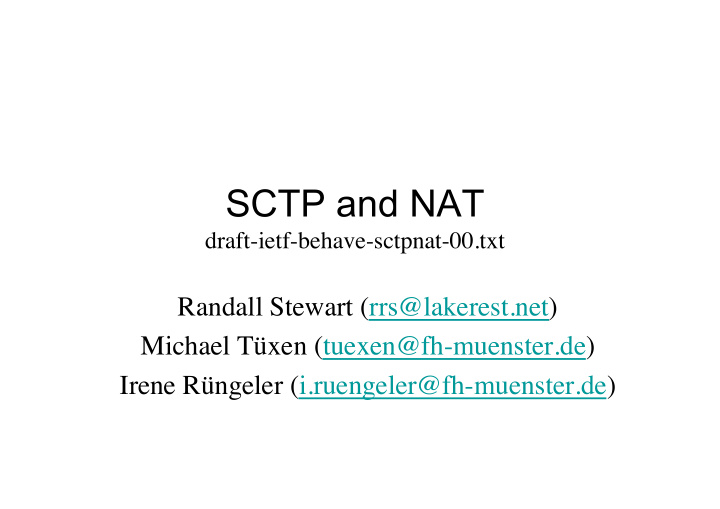



SCTP and NAT draft-ietf-behave-sctpnat-00.txt Randall Stewart (rrs@lakerest.net) Michael Tüxen (tuexen@fh-muenster.de) Irene Rüngeler (i.ruengeler@fh-muenster.de)
Message Format Common Header First Chunk Second Chunk Third Chunk Last Chunk
Common Header Format Source Port Destination Port Verification Tag Checksum
A NAT with NAPT capabilities for SCTP • Does not use the port numbers to identify the SCTP association, but the verification tag. • The IP address is modified based on the port numbers and the verification tag. • No recalculation of the checksum is necessary. • No change of the port number is required. • If an ephemeral port number is used one has a 32+14 = 46 bit random number for identifying the association. • Every packet contains only one verification tag (except for the INIT-ACK).
Changes • Address single- and multi-homed scenarios. • Address client-server and peer to peer scenarios. • Adopted terminology. • Clarified figures. • We added a lot of examples, showing the message flow and the state changes in the NAT box. • Addressed all comments we got.
Terminology Internal Network | External Network | Private | Public External +---------+ Address | Address /--\/--\ Address +---------+ | SCTP | +-----+ / \ | SCTP | |end point|==========| NAT |======= | Internet | ========== |end point| | A | +-----+ \ / | B | +---------+ Internal | \--/\--/ External +---------+ Internal Port | Port External VTag | VTag
Implementations • The Swinburne University of Technology has implemented the middlebox behavior on FreeBSD. • Münster University of Applied Sciences has implemented implemented the middlebox and endpoint behavior in a simulation tool. • Münster University of Applied Sciences is working on the middlebox behavior on Linux. • Endpoint behavior on FreeBSD is also coming…
To Do • Incorporate some of the comments received form the Swinburne University of Technology. • Add some more examples. • IPv6?
Questions
Recommend
More recommend